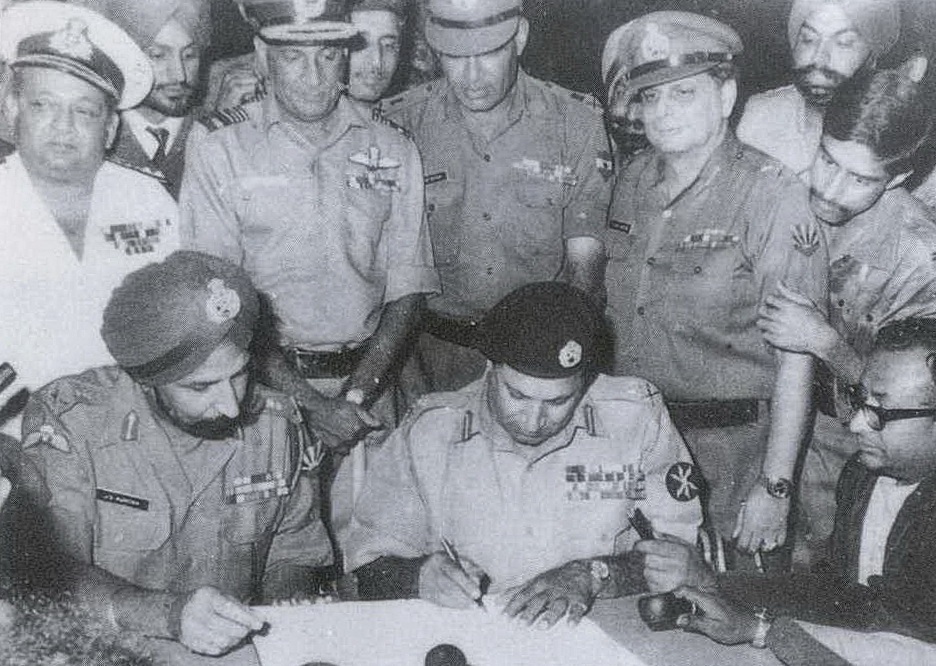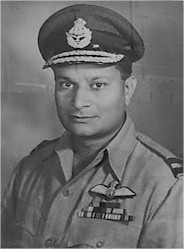|
Erlic Pinto
Air Vice Marshal Erlic Wilmot Pinto, PVSM (29 June 1921 – 22 November 1963) was an Air officer in the Indian Air Force. He was the Air Officer Commanding-in-Chief (AOC-in-C) Western Air Command when he was killed in the 1963 Poonch Indian Air Force helicopter crash. He served in the IAF from 1940 until his death in 1963. He was the theatre air commander commanding the air operations during the Annexation of Goa. Early life and education Erlic Pinto was born on 29 June 1921 into the Pinto do Rosario family of Porvorim, Goa. His brothers Fausto and Norman also served in the Indian Armed Forces. Fausto joined the Indian Navy and retired as a Rear Admiral while Norman joined the Indian Army and retired as a captain. He attended the St. Paul's School, Belgaum and the St. Xavier's College, Mumbai. Military career World War II In August 1940 Pinto was seconded to the UK along with 23 other trained Indian pilots. He served with the No. 12 Squadron RAF from 1940 to 1942. In ... [...More Info...] [...Related Items...] OR: [Wikipedia] [Google] [Baidu] |
Porvorim
Porvorim (pronounced ), is the '' de facto'' legislative and executive capital of the state of Goa as both the Goa Legislative Assembly and Secretariat are functioning from the same complex in the region of Alto Porvorim in porvorim.(Alto – Portuguese word meaning high or upper). It is also the '' De facto'' judicial capital of Goa. The High Court of Bombay at Goa (Bombay High Court – Panaji Bench) is now functioning from here in a new building complex overlooking the Mandovi river. Earlier it was functioning from the Lyceum complex in Panaji. Porvorim is situated on the right bank (north bank) of the Mandovi River, as ''de jure'' capital of Goa, Panaji is located on the opposite bank. Porvorim is considered an upmarket residential hub as it lies on the Mumbai Mumbai ( ; ), also known as Bombay ( ; its official name until 1995), is the capital city of the Indian state of Maharashtra. Mumbai is the financial capital and the most populous city proper of India ... [...More Info...] [...Related Items...] OR: [Wikipedia] [Google] [Baidu] |
Battle Of Imphal
The Battle of Imphal () took place in the region around the city of Imphal, the capital of the state of Manipur in Northeast India from March until July 1944. Empire of Japan, Japanese armies attempted to destroy the Allied forces at Imphal and invade British Raj, India, but were driven back into Burma with heavy losses. Together with the simultaneous Battle of Kohima on the road by which the encircled Allied forces at Imphal were relieved, the battle was the turning point of the Burma campaign, part of the South-East Asian theatre of World War II. The Japanese defeat at Battle of Kohima, Kohima and Imphal was the largest up until that time,Bond, Tachikawa p. 122 with many of the Japanese deaths resulting from starvation, disease and exhaustion suffered during their retreat. According to voting in a contest run by the British National Army Museum, the Battle of Imphal was bestowed as Britain's Greatest Battle in 2013. Situation Background In March 1943, the Japanese command i ... [...More Info...] [...Related Items...] OR: [Wikipedia] [Google] [Baidu] |
Chindits
The Chindits, officially known as Long Range Penetration Groups, were special operations units of the British and Indian armies which saw action in 1943–1944 during the Burma Campaign of World War II. Brigadier Orde Wingate formed them for long-range penetration operations against the Imperial Japanese Army, especially attacking lines of communication deep behind Japanese lines. The name Chindits is a corrupted form of ''Chinthe'' (),Brayley 2002, p. 18. Burmese word for "lion". Their operations featured long marches through extremely difficult terrain, undertaken by underfed troops often weakened by diseases such as malaria and dysentery. Controversy persists over the extremely high casualty rate and the debatable military value of the achievements of the Chindits. Background and formation During the East African Campaign of 1940–41, Wingate – under General Archibald Wavell, Commander-in-Chief of the Middle East Command – had begun to explore guerilla tact ... [...More Info...] [...Related Items...] OR: [Wikipedia] [Google] [Baidu] |
Dive Bomber
A dive bomber is a bomber aircraft that dives directly at its targets in order to provide greater accuracy for the bomb it drops. Diving towards the target simplifies the bomb's trajectory and allows the pilot to keep visual contact throughout the bomb run. This allows attacks on point targets and ships, which were difficult to attack with conventional level bombers, even ''en masse''. Dive bombing was especially effective against vehicles when integrated into early instances of Blitzkrieg. After World War II, the rise of precision-guided munitions and improved anti-aircraft defences—both fixed gunnery positions and fighter interception—led to a fundamental change in dive bombing. New weapons, such as rockets, allowed for better accuracy from smaller dive angles and from greater distances. They could be fitted to almost any aircraft, including fighters, improving their effectiveness without the inherent vulnerabilities of dive bombers, which needed air superiority to ... [...More Info...] [...Related Items...] OR: [Wikipedia] [Google] [Baidu] |
Vultee A-31 Vengeance
The Vultee A-31 Vengeance is an American dive bomber of World War II that was built by Vultee Aircraft. A modified version was called A-35. The Vengeance was not used operationally by the United States but was operated as a front-line aircraft by the Royal Air Force, the Royal Australian Air Force, and the Royal Indian Air Force in South-East Asian theatre of World War II, Southeast Asia and the South West Pacific theatre of World War II, Southwest Pacific. The A-31 remained in service with U.S. units until 1945, primarily as a target-tug. Design and development In 1940, Vultee Aircraft started the design of a single-engined dive-bomber, the Vultee Model 72 (V-72) to meet the requirements of the French History of the Armée de l'Air (1909–1942), ''Armée de l'Air''. The V-72 was built with private funds and was intended for sale to foreign markets. The V-72 was a low-wing, single-engine monoplane with a closed cockpit and a crew of two. An air-cooled radial Wright Twin Cyclone ... [...More Info...] [...Related Items...] OR: [Wikipedia] [Google] [Baidu] |
Pratap Chandra Lal
Air Chief Marshal Pratap Chandra Lal, DFC (6 December 1916 – 13 August 1982) was the Chief of Air Staff (CAS) of the Indian Air Force (IAF) during the Indo-Pakistani War of 1971. He served in the IAF from 1939 until his retirement in 1973. He was the CAS at the time of Operation Chengiz Khan, the preemptive strikes that were carried out by the Pakistan Air Force (PAF) that marked the formal initiation of hostilities of the war. Slated to study law in England, Lal instead joined the Air Force Volunteer Reserve at the outbreak of World War II. After serving as a navigation instructor, he trained as a pilot and joined No. 7 Squadron IAF. He later commanded this squadron during the Burma Campaign and mentioned in dispatches as well as being awarded the Distinguished Flying Cross. In 1945, he was absorbed into the permanent cadre of the Indian Air Force. After the Partition of India in 1947, he served as the Director of Planning and Training at Air HQ. In 1949, he attende ... [...More Info...] [...Related Items...] OR: [Wikipedia] [Google] [Baidu] |
Flight (military Unit)
A flight is a small military unit within the larger structure of an air force, naval air service, or army air corps; and is usually subordinate to a larger squadron. A military aircraft flight is typically composed of four aircraft, though two to six aircraft may also form an aircraft flight; along with their aircrews and ground staff. In some very specific examples, typically involving historic aircraft, a flight may contain as many as twelve aircraft, as is the case with the Battle of Britain Memorial Flight (BBMF) of the British Royal Air Force (RAF). In most usages, two or more flights make up a squadron. Foreign languages equivalents include ( French), ( Spanish), ( Portuguese), ''lanka'' ( Ukrainian), ( Romanian), ( Russian), and ( German). In the case of a non-flying, or "ground flight", such as Mechanical Transport Flight (MTF), Supply Flight, Accounts Flight, etc; no aircraft, and a roughly equivalent number of support personnel may be utilised. The term " ... [...More Info...] [...Related Items...] OR: [Wikipedia] [Google] [Baidu] |
24 Indian Pilots (1940)
In 1940, 24 Indian pilots, also known as the X-squad, were chosen from 72 trainees of the Indian Airforce 4th Pilot's Course and sent to the UK for operational training and squadron service with the Royal Air Force Volunteer Reserve (RAFVR). The pilots included Ranjan Dutt, Erlic Pinto, Erlic W. Pinto, Hari Chand Dewan, Hari C. Dewan, Mohinder Singh Pujji, Mahinder Singh Pujji and Man Mohan Singh (pilot), Man Mohan Singh. Of the 24, 16 qualified as pilots and six were posted to non-flying duties. Eight completed further training as fighter pilots and served in Royal Air Force (RAF) squadrons after the Battle of Britain. Others were selected for RAF Bomber Command, Bomber/RAF Coastal Command during World War II, Coastal Command. Eight were killed during training or in action. Some of those who survived became Air Marshalls in the Indian Air Force (IAF) after independence. Recruitment In 1940, the Air Ministry requested the British Raj, British Government in India to send Indian ... [...More Info...] [...Related Items...] OR: [Wikipedia] [Google] [Baidu] |
Captain (armed Forces)
The army rank of captain (from the French ) is a commissioned officer rank historically corresponding to the command of a company of soldiers. The rank is also used by some air forces and marine forces, but usually refers to a more senior officer. History The term ultimately goes back to Late Latin meaning "head of omething; in Middle English adopted as in the 14th century, from Old French . The military rank of captain was in use from the 1560s, referring to an officer who commands a company. The naval sense, an officer who commands a man-of-war, is somewhat earlier, from the 1550s, later extended in meaning to "master or commander of any kind of vessel". A captain in the period prior to the professionalization of the armed services of European nations subsequent to the French Revolution, during the early modern period, was a nobleman who purchased the right to head a company from the previous holder of that right. He would in turn receive money from another nobleman t ... [...More Info...] [...Related Items...] OR: [Wikipedia] [Google] [Baidu] |
Indian Army
The Indian Army (IA) (ISO 15919, ISO: ) is the Land warfare, land-based branch and largest component of the Indian Armed Forces. The President of India is the Commander-in-Chief, Supreme Commander of the Indian Army, and its professional head is the Chief of the Army Staff (India), Chief of the Army Staff (COAS). The British Indian Army, Indian Army was established on 1 April 1895 alongside the long established presidency armies of the East India Company, which too were absorbed into it in 1903. Some princely states maintained their own armies which formed the Imperial Service Troops which, along with the Indian Army formed the land component of the Armed Forces of the Crown of India, responsible for the defence of the Indian Empire. The Imperial Service Troops were merged into the Indian Army after Independence of India, independence. The units and regiments of the Indian Army have diverse histories and have participated in several battles and campaigns around the world, earnin ... [...More Info...] [...Related Items...] OR: [Wikipedia] [Google] [Baidu] |






